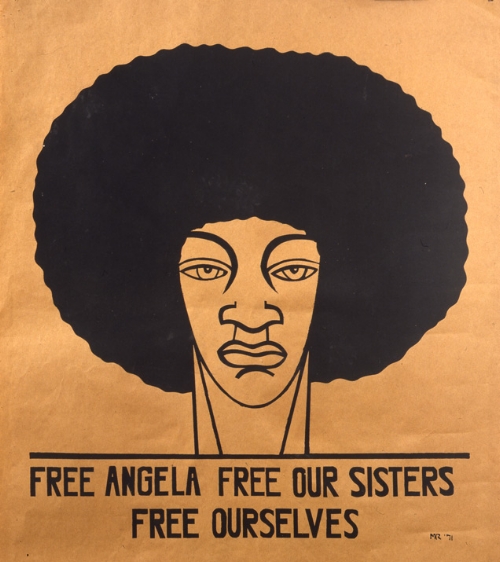Poster for Free Angela Davis campaign, silkscreen on paper, 30" x 24", 1971
Art for Social Justice
At the age of six, on an isolated lake in northern Indiana, I was raped by the man next door, who threatened to drown me if I told. This experience led me to be extraordinarily conscious of human suffering, or abuse. My reverence for life is not just for human beings, but extends to life of any kind. I cannot resist, for example, even in public places, from placing my hand inside a plant to make sure it has been watered and cared for.
Because I always felt on the outside, and without friends—how could anyone understand what I had gone through? I thought—I identified and felt comfortable with people on the fringes of society, in short, wherever I witnessed injustice.
I always had many friends, however, because I was loving and empathic. But I never shared my secrets, and consequently, though people loved me and felt close to me, and though I sincerely loved them, I still felt different, and alone.
The death threat turned me into a hard-core existentialist. I lived/live in the present, aware of the importance of every single minute of life. I have never taken life for granted—not just my life, but anyone’s life, all life.
Growing up in segregated Indianapolis, Indiana, with family members and neighbors who were racist and anti-Semitic, I soon began to argue fiercely against opinions that I could not tolerate, and began a life of heightened social consciousness.
My young beliefs were supported and directed by the very progressive minister of the church I attended. By the age of ten, he was teaching me that I did not have to go along with intolerant thought or action, including that of my own father. He took me to observe his daughter picketing Woolworth’s in solidarity with the sit-ins in the South. Watching this protest helped me to begin to understand the importance of taking action, and I soon began to join the demonstrations.
With the guidance of my minister, I began to organize inter-racial and inter-faith study groups around the city, in neutral places such as libraries and schools. In early adolescence, he asked me to speak from the pulpit on Sundays—short, impassioned talks about civil rights. He took me to churches in other towns in this “Red State” to do the same. I soon became a State officer in that denomination’s youth fellowship, and ultimately, a national officer and delegate to an international conference of churches in Switzerland.
Throughout my life, I have worked, and organized other artists to work, on a volunteer basis in prisons, orphanages, churches, and almost anywhere I saw a need for reform. Consequently my art has always reflected the people I knew and the experiences I had within this context.

